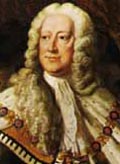Georg August was the only son of Georg Ludwig, the future Duke of Brunswick and Lüneburg. On 11/22 Aug 1705 he married Wilhelmina Charlotte Caroline of Brandenburg-Ansbach, who wielded great influence over her husband and thereby on government. Upon the accession (1/12 Aug 1714) of his father to the British throne as George I, he became heir apparent and was created Prince of Wales on 27 Sep/8 Oct 1714. Georg August succeeded to his father in 1727 as King George II. As in the time of George I, the German affairs also dominated the reign of George II, who often visited Hanover leaving Queen Caroline as regent. The Whig administration under Sir Robert Walpole enjoyed a majority in the House of Commons for over two decades. In 1729 Great Britain signed the Treaty of Seville with Spain, which confirmed Gibraltar under British rule. The death of Caroline (20 Nov/1 Dec 1737), who supported Walpole, heralded decline in Walpole's influence. In 1740 Great Britain entered the war of the Austrian Succession. On 16/27 Jun 1743 George II defeated the French at the battle of Dettingen, but the war continued until 1748. The second Jacobite Rebellion began when Charles Edward Stuart landed in mainland Scotland (25 Jul/5 Aug 1745) and proclaimed his father, James, King of England and Scotland. However, the defeat of the Jacobite forces at Culloden (16/27 Apr 1746) marked the end of any serious attempt by the Jacobites to restore the Stuart dynasty to the British throne. During the last decade of his life George's interest in politics declined and he relied mostly on his ministers, Henry Pelham and William Pitt. In 1756 Britain declared war on France, thus beginning the Seven Years' War (1756-1763). Hanover, invaded by the French troops in 1757, was regained by the victory at Warburg, three months prior to George II's death. [4] |

